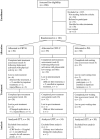Immunological effects of behavioral activation with exercise in major depression: an exploratory randomized controlled trial
- PMID: 28509904
- PMCID: PMC5534946
- DOI: 10.1038/tp.2017.76
Immunological effects of behavioral activation with exercise in major depression: an exploratory randomized controlled trial
Abstract
Major depression (MD) is associated with peripheral inflammation and increased cardiovascular risk. Regular physical exercise can have anti-inflammatory effects. The present study examined whether behavioral activation with exercise affects inflammatory processes in MD. Ninety-eight patients with MD were randomly assigned to cognitive-behavioral therapy (CBT) emphasizing exercise during behavioral activation (CBT-E), CBT with pleasurable low-energy activities as an active control condition (CBT-C) or a passive waiting list control group (WL). Plasma levels of C-reactive protein (CRP), interleukin (IL)-6, IL-10, lipopolysaccharide (LPS)-stimulated IL-6 production, and blood immune cell counts were analyzed at baseline and weeks 8 (post-behavioral activation) and 16 (post-treatment). Thirty non-depressed age- and sex-matched controls were included to examine potential immunological alterations in MD at baseline. Patients with MD exhibited higher levels of CRP, higher neutrophil and monocyte counts, lower IL-10 levels and reduced LPS-stimulated IL-6 production compared to controls (P<0.001-0.045). Multilevel modeling indicated that CBT-E was associated with increased anti-inflammatory IL-10 at weeks 8 and 16 compared to CBT-C and WL (P=0.004-0.018). CBT-E did not significantly affect other immunological makers in the total sample. A subgroup analysis including patients with potentially higher cardiovascular risk (CRP ⩾1 μg ml-1) indicated that CRP was reduced in CBT-E compared to CBT-C (P<0.007) and marginally reduced compared to WL (P<0.085) after week 16. The present findings provide new insights into immunological effects of behavioral treatments against depression. Behavioral activation in conjunction with exercise may have the potential to reverse, in part, immunological alterations in MD.
Conflict of interest statement
WR received honoraria for presentations and consultation about placebo mechanisms from Berlin Chemie, Bayer and Heel. ClinicalTrials.gov Identifier: NCT01464463 (The Impact of Psychological Interventions on Psychometric and Immunological Measures in Patients with Major Depression). The remaining authors declare no conflict of interest.
Figures



Similar articles
-
Effects of cognitive behavioural therapy on verbal learning and memory in major depression: Results of a randomized controlled trial.Clin Psychol Psychother. 2019 May;26(3):291-297. doi: 10.1002/cpp.2350. Epub 2019 Jan 20. Clin Psychol Psychother. 2019. PMID: 30614136 Clinical Trial.
-
Does psychological treatment of major depression reduce cardiac risk biomarkers? An exploratory randomized controlled trial.Psychol Med. 2023 Jun;53(8):3735-3749. doi: 10.1017/S0033291722000447. Epub 2022 Mar 2. Psychol Med. 2023. PMID: 35232509 Free PMC article. Clinical Trial.
-
Biomarkers as predictors of CBT responsiveness in major depressive disorder: The role of heart rate variability and inflammation.J Psychosom Res. 2024 Nov;186:111885. doi: 10.1016/j.jpsychores.2024.111885. Epub 2024 Aug 13. J Psychosom Res. 2024. PMID: 39180963 Clinical Trial.
-
Novel Augmentation Strategies in Major Depression.Dan Med J. 2017 Apr;64(4):B5338. Dan Med J. 2017. PMID: 28385173 Review.
-
Specific psychotherapies for childhood and adolescent depression.Biol Psychiatry. 2001 Jun 15;49(12):1091-100. doi: 10.1016/s0006-3223(01)01130-1. Biol Psychiatry. 2001. PMID: 11430851 Review.
Cited by
-
These methods from psychiatry can help you beat stress during the coronavirus pandemic.Nature. 2020 Jun 2. doi: 10.1038/d41586-020-01657-2. Online ahead of print. Nature. 2020. PMID: 32488190 No abstract available.
-
Disentangling the biological mechanisms underlying the effects of physical exercise in major depressive disorder: a comprehensive systematic review of randomized controlled trials.Psychol Med. 2025 Jul 16;55:e197. doi: 10.1017/S0033291725100743. Psychol Med. 2025. PMID: 40665827 Free PMC article.
-
Current Perspectives on Pharmacological and Non-Pharmacological Interventions for the Inflammatory Mechanism of Unipolar Depression.Brain Sci. 2022 Oct 18;12(10):1403. doi: 10.3390/brainsci12101403. Brain Sci. 2022. PMID: 36291336 Free PMC article. Review.
-
The future is dynamic: A call for intensive longitudinal data in immunopsychiatry.Brain Behav Immun. 2023 Aug;112:118-124. doi: 10.1016/j.bbi.2023.06.002. Epub 2023 Jun 5. Brain Behav Immun. 2023. PMID: 37286174 Free PMC article.
-
Exercise for patients with major depression: a systematic review with meta-analysis and trial sequential analysis.BMJ Open. 2017 Sep 18;7(9):e014820. doi: 10.1136/bmjopen-2016-014820. BMJ Open. 2017. PMID: 28928174 Free PMC article.
References
-
- Dowlati Y, Herrmann N, Swardfager W, Liu H, Sham L, Reim EK et al. A meta-analysis of cytokines in major depression. Biol Psychiatry 2010; 67: 446–457. - PubMed
-
- Howren MB, Lamkin DM, Suls J. Associations of depression with C-reactive protein, IL-1, and IL-6: a meta-analysis. Psychosom Med 2009; 71: 171–186. - PubMed
Publication types
MeSH terms
Substances
LinkOut - more resources
Full Text Sources
Other Literature Sources
Medical
Research Materials
Miscellaneous

